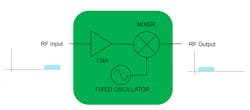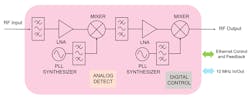Extend Existing RF Analyzers to mmWave 5G Frequencies
Members can download this article in PDF format.
What you'll learn:
- Why 5G is pushing the limits of current RF equipment.
- Implementing RF downconverters can alleviate many challenges, but simple approaches have limitations.
- Why a more sophisticated approach to downconversion helps existing equipment easily contend with 5G.
After years of research and testing, 5G wireless networks are being deployed in cities around the world. Leveraging mmWave frequencies well above the bands used before, 5G wireless promises rapid speeds, wide bandwidths, near real-time latency, and extremely high capacity.
However, these high-frequency signals create unique challenges for mobile operators, RF equipment providers, researchers, and RF engineers conducting analysis in the field. Deploying and optimizing 5G networks will require more extensive testing, propagation analysis, and coverage mapping to ensure performance. RF interference or other sources of disruption must be quickly identified and resolved, while ongoing remote monitoring and drive tests are needed to maintain reliable connectivity for users.
RF downconverters/tuners provide a portable, easy-to-use, and economical solution by increasing the performance of existing spectrum-analysis equipment into 5G. Rather than replace current test and measurement equipment, users can integrate with an RF downconverter to extend the range of their hardware into mmWave signals for applications such as data recording, spectrum monitoring, signal analysis, RF drive test, and RF research and development.
By taking this approach, users can conduct analysis and testing when deploying and optimizing 5G networks. Compared to upgrading to new hardware, users reduce capital expenses, minimize additional training for engineers in the field, and maintain their current test setups and equipment.
The Changing Requirements for 5G Wireless
From the early 1G networks in the 1980s up to the 4G/LTE networks most of us connect to every day, each generation of wireless technology has boosted performance, functionality, and coverage.
However, while performance and bandwidth increased with every new standard, the frequencies they each operated on generally remained the same (Fig. 1). Mobile networks typically operated at bands below 6 GHz. As a result, the equipment used to analyze these signals was designed to capture signals up to 6 GHz as well.
5G wireless, on the other hand, is expected to operate in different bands depending on the application and performance requirements. Low- and mid-band signals under 6 GHz will continue to be used in rural environments or other applications where range, penetrability, and coverage are more important than speed or bandwidth. These bands also will be important as mobile operators leverage existing 3G/4G/LTE infrastructure to build out their 5G networks.
However, the real 5G experience will be delivered with networks operating in the mmWave bands currently operating in the 24- to 40-GHz range. These high-frequency signals will be used in dense, urban environments or other applications that require increased speed, bandwidth, and capacity.
The propagation characteristics of such high-band signals are less well-understood, and higher-frequency signals are more affected by barriers such as buildings, walls, trees, and even people. Mobile operators will therefore need to conduct extensive testing and optimization as they deploy mmWave 5G networks.
Over-the-Air Measurements
Channel propagation and characterization are critical for a new 5G deployment as the properties of mmWave signals are less known than those under 6 GHz. In one case, a user was interested in running channel-propagation measurements in the field at 28 GHz. The user had transmitters, antennas, and a 6-GHz spectrum analyzer. By integrating with an RF downconverter (such as thinkRF's D4000 RF downconverter/tuner), they were able to downconvert the 28-GHz signals and process them without any changes to their equipment, code, or setup.
This means that mobile operators are left with a choice. They can decide to replace their existing equipment with spectrum analyzers that capture up to 40 GHz; or they can choose to extend the life and performance of their existing hardware by integrating with an RF downconverter/tuner.
In most cases, especially in the near and medium term, mobile operators will want to reduce costs, deploy equipment and networks more rapidly, cut down on the training requirements for engineers in the field, and maximize the ROI of their current equipment by integrating with an RF downconverter.
Simple Downconversion Approaches are Limited
RF downconverters extend the performance of existing analysis equipment by capturing high-frequency signals and converting them to a lower range. By integrating with a downconverter, a spectrum analyzer can process signals that would otherwise be outside of its frequency range.
Only a few components are needed to build a simple downconverter. As shown in Figure 2, a basic downconverter can be designed using a low-noise amplifier (LNA), a mixer, and a fixed oscillator.
While this approach may be simple, it ultimately creates more challenges for users because it only enables block downconversion. The entire frequency range captured by the downconverter is converted into a block of spectrum, which is then input into the analyzer operating over a lower frequency range.
For example, a 24- to 40-GHz RF downconverter designed using this simple approach captures a 16-GHz block of spectrum. The 24-GHz band is converted to dc, while the 40-GHz band is converted to 16 GHz. A 6-GHz analyzer would be unable to process the entire block of downconverted spectrum.
Even if the signal of interest falls within the range of the analyzer, a simple approach raises additional challenges. Because every LNA and mixer has gain characteristics that change with frequency, the downconverted signal would not be calibrated. This makes it impossible to see key properties, such as the amplitude of the signal at the RF input port.
Similarly, due to the lack of any front-end filtering, there’s the risk of creating spurious signals or increasing the noise floor to a level where the signal of interest is hidden.
Finally, an approach using off-the-shelf components requires a large form factor and complex integration. Extensive RF expertise is required to successfully integrate equipment, while the increased size, weight, and power requirements make the combined solution unsuitable for use in the field.
As a result, it’s far better for operators to integrate with a more sophisticated RF downconverter/tuner that takes on more complexity in the unit itself. With more capabilities and better performance, the user gets a simple, easy-to-use, and economical solution.
Consider the case of a wireless service provider with a very large existing installed base of handheld spectrum analyzers. Rather than replace or upgrade their equipment, they wanted to extend the hardware's range to 28 GHz for interference-hunting applications. Furthermore, they did not want to have to retrain their technology staff on new equipment.
An RF downconverter/tuner extended the performance of their handheld spectrum analyzers to 28 GHz. Calibration ensured that signal properties were maintained, and the small form factor easily integrated with their existing analyzers for use in the field. In addition, no new user training was required with this plug-and-play solution.
A More Sophisticated Approach
Unlike a typical downconverter that converts a block of spectrum, thinkRF's D4000 RF downconverter/tuner outputs to a single IF frequency centered at 1.5 GHz. The user simply tunes their receiver or spectrum analyzer to 1.5 GHz, tunes the D4000 to the desired frequency of interest between 24 and 40 GHz, and processes the signal using their existing equipment and test setup.
The D4000 features 500-MHz real-time bandwidth (RTBW) for wideband signal analysis. Multiple units can be synchronized using the 10-MHz input and output clock references. By tuning each unit to a center frequency that’s 250 MHz apart, the user can aggregate the analog response in the receiver to achieve more than 500-MHz RTBW.
To provide this level of performance and ease of use, the D4000 analyzer hides a lot of complexity from the user. As shown in Figure 3, gain blocks optimize the signal for the best noise figure possible, while built-in tunable local oscillators and pre-select filtering reject out-of-band signals that would result in spurs or interference. This eliminates the need for external synthesizers and enables interference hunting or other low-power, over-the-air signal-detection applications.
Calibration also enables accurate signal measurement and easy integration with calibrated equipment. Compared to the simple approach, amplitude and other properties at the RF input are known based on the signal out of the downconverter/tuner, allowing for more accurate and in-depth analysis.
The D4000 downconverter/tuner, controlled via a PC, across a network, or through the spectrum analyzer, uses standard SCPI controls over Ethernet. A rich suite of APIs and programming environments, including C, C++, and Python, enable users to run their existing applications with minimal integration requirements.
Finally, the D4000 achieves this performance in a compact unit. Measuring 7.6 × 7.6 × 1.6 and weighing less than 4 lb., the downconverter can connect to a spectrum analyzer in the field without significantly increasing size, weight, or power.
Distributed, Network Architecture for 24/7 RF Monitoring
5G wireless requires operators to monitor signals over wide geographic areas. Interference may appear in random locations at random points in time, disrupting networks and cellular communication. By the time an engineer drives out to locate the source, it may already be gone.
With remote sensors, operators can conduct 24/7 persistent monitoring to automatically alert a central location to interference or other disruptions. By integrating with an RF downconverter/tuner such as the D4000 with open APIs, operators needn’t change existing infrastructure and can retain the same code, setup, user interface, and training programs while capturing 5G wireless signals.
Extending RF Performance into mmWave 5G Frequencies
5G wireless networks promise to bring in a new era of innovation and technology. A high-speed, reliable network is critical as more technologies and applications depend on 5G networks.
However, 5G technologies introduce new challenges for mobile operators, RF equipment providers, researchers, and RF engineers. As mobile operators deploy, test, and optimize these networks, they need to increase the performance of their existing spectrum analysis and test and measurement equipment.



